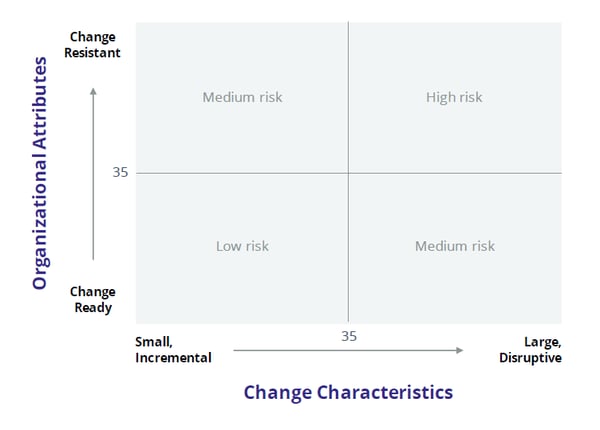3 Steps to Scaling Change Management

2 Mins
Updated: November 18, 2025
Published: October 4, 2022

In brief: One size does not fit all. The "right" change management approach for a particular project must be scaled and customized to meet the unique needs of that change.
A growing number of organizations are applying change management methodologies. In 2003, only 34% of participants in Prosci's Best Practices in Change Management benchmarking study were using a methodology. This percent has continued to grow, and in 2011 72% were using a methodology.
Selecting a methodology for managing the people side of change is important for establishing structure, rigor and repeatability, but that's only the first step. One size does not fit all, so once the methodology has been selected, scaling and customizing the approach is critical in order to manage a successful change. Change management is most effective when it is flexible and scaled to fit the particular change at hand. No two changes will require exactly the same process or same level of change management.
In the 2011 study, participants identified "ease of use and scalability" as the most important characteristic of a methodology. Participants recognized that a change management methodology is not just a checklist; it's a guide to help you think critically about factors that are unique to your change, organization and culture (to name a few) in order to scale and customize the way you manage a given change.
Research Findings
Participants pointed out the importance of scalability in 2011, so we asked participants in Prosci's 2013 study to explain what considerations went into scaling or customizing the methodology to their specific project. They considered the following factors:
- Project characteristics, including scope, size, type, complexity, objective and timing
- Change management assessment results, including results from current state assessments, impact assessments, change readiness assessments and gap analyses
- Organizational attributes, including culture, size, industry, structure and strategic initiatives
The change management methodology should provide a framework and set of tools that guide you in addressing these considerations with the overall goal of defining the change and building a custom change plan.
Scaling in the Prosci 3-Phase
Change Management Process
The Prosci 3-Phase Change Management Process provides steps, activities and tools that are scaled and applied to support changes, large and small, radical and incremental, with large impact or minimal impact. It is built in three phases, with the first focusing on Preparing for change.
Each of the steps, activities and tools in this phase guide the scaling and customizing of your change management plan. In particular, the first step Define your change management strategy includes activities such as:
- Sizing your change initiative and identifying change characteristics (which involves scoping the change, identifying impacted individuals and groups, defining the type of change and determining the amount of change)
- Understanding the unique characteristics of the impacted organizations (which involves analyzing the organization's value system and culture, capacity for change and structure of the organization)
- Creating a change management strategy (which involves identifying the team structure, sponsor model, special tactics to deal with known problem areas and assessing the risk)

The output of these activities is the situational awareness you need to adequately scale your change management efforts. In the Prosci 3-Phase Change Management Process, a risk grid is generated from the Prosci Change Characteristics and Organizational Attributes Assessments.
 Your location in the risk grid is based on two Phase 1 assessments. Customization guidelines are provided for each of the five change management plans based on your location in the risk grid:
Your location in the risk grid is based on two Phase 1 assessments. Customization guidelines are provided for each of the five change management plans based on your location in the risk grid:
- Communications plan
- Sponsor roadmap
- Coaching plan
- Training plan
- Resistance management plan



